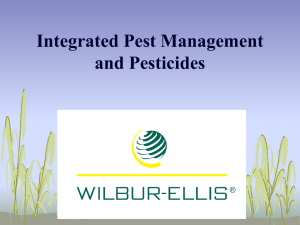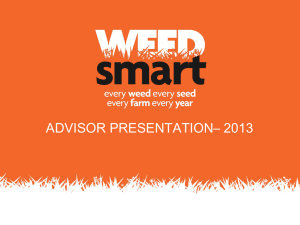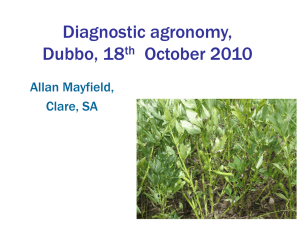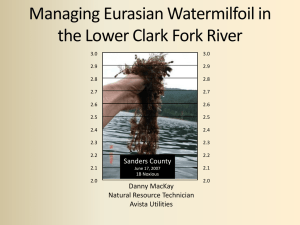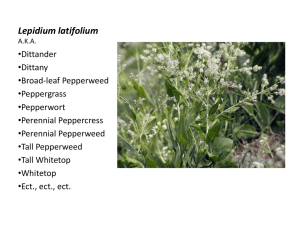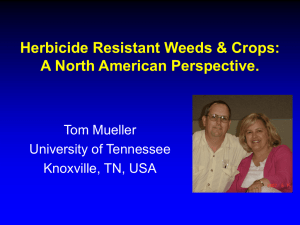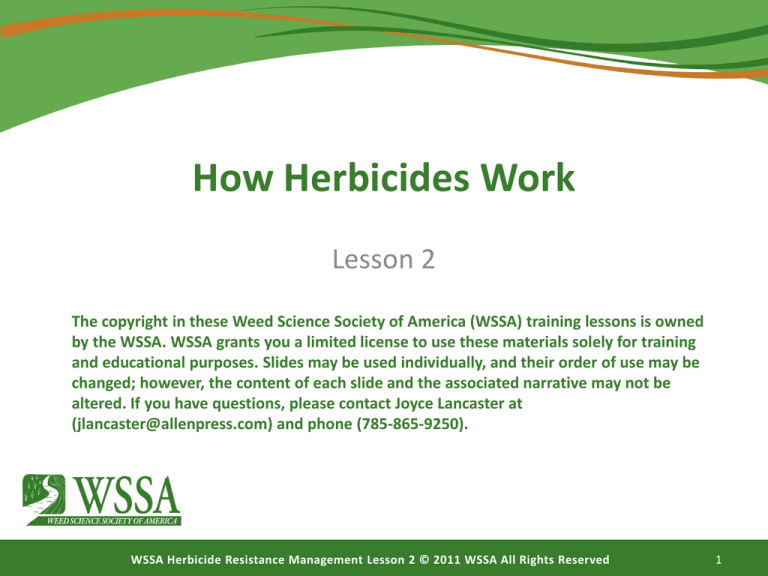
How Herbicides Work
Lesson 2
The copyright in these Weed Science Society of America (WSSA) training lessons is owned
by the WSSA. WSSA grants you a limited license to use these materials solely for training
and educational purposes. Slides may be used individually, and their order of use may be
changed; however, the content of each slide and the associated narrative may not be
altered. If you have questions, please contact Joyce Lancaster at
(jlancaster@allenpress.com) and phone (785-865-9250).
Herbicide
Resistance
Management
▪ Lesson
HowWSSA
do herbicides
work?
WSSA Herbicide
Resistance
Management
Lesson
2 ©2:2011
All Rights
Reserved
1
Objectives
By the end of this lesson, you will:
Know the terminology associated with
herbicide use, including tolerance,
chemistry, efficacy, timing, and
placement of applications.
Understand how herbicides are
categorized according to their
mechanism of action.
Above: Inflorescence of wild oat, a
weed that is known to be resistant to
several herbicides.
Image number 5404825 at www.invasive.org.
Herbicide
Resistance
Management
▪ Lesson
HowWSSA
do herbicides
work?
WSSA Herbicide
Resistance
Management
Lesson
2 ©2:2011
All Rights
Reserved
2
What is a Herbicide?
Herbicide
Resistance
Management
▪ Lesson
HowWSSA
do herbicides
work?
WSSA Herbicide
Resistance
Management
Lesson
2 ©2:2011
All Rights
Reserved
3
Definitions Related to Herbicides
Herbicide
Resistance
Management
▪ Lesson
HowWSSA
do herbicides
work?
WSSA Herbicide
Resistance
Management
Lesson
2 ©2:2011
All Rights
Reserved
4
Herbicide Names on a Label
The Trade name or Product name,
describes the formulated product
and may contain more than one a.i.
Common
name of a.i.
Chemical name
of a.i.
Herbicide
Resistance
Management
▪ Lesson
HowWSSA
do herbicides
work?
WSSA Herbicide
Resistance
Management
Lesson
2 ©2:2011
All Rights
Reserved
5
Herbicide Efficacy
Example:
• For many weed species, a
herbicide controlling 85% or
more of the target weed
population has good efficacy.
• The weeds are susceptible to
the herbicide.
Controlled
Herbicide
Resistance
Management
▪ Lesson
HowWSSA
do herbicides
work?
WSSA Herbicide
Resistance
Management
Lesson
2 ©2:2011
All Rights
Reserved
6
Herbicide Tolerance
Herbicide resistance
Herbicide tolerance is the inherent ability of a species
to survive
can be defined
as the
acquired ability
a
and reproduce after herbicide treatment. This implies
thatofthere
weed population to
was no selection or genetic manipulation to make
thea herbicide
plant
survive
previously known to be
tolerant; it is naturally tolerant.
susceptible to that
herbicide. Resistance is
Selective herbicides are effective
more fully explained in
Some herbicides are
effective
because the crop is tolerant to
Lesson 3.
only on some weeds.
the herbicide.
[Click to close.]
Herbicide tolerance is not synonymous with herbicide resistance.
By definition, if a weed has never been controlled and there
has been no change in the weed population’s lack of
response to a herbicide over time, the population is
tolerant.
Herbicide
Resistance
Management
▪ Lesson
HowWSSA
do herbicides
work?
WSSA Herbicide
Resistance
Management
Lesson
2 ©2:2011
All Rights
Reserved
7
Herbicide Spectrum of Control
Narrow Spectrum: A herbicide that is more effective in
controlling some plant species than others.
No
activity
No
activity
Activity
Broad Spectrum: A herbicide that controls many plant
species.
Herbicide
Resistance
Management
▪ Lesson
HowWSSA
do herbicides
work?
WSSA Herbicide
Resistance
Management
Lesson
2 ©2:2011
All Rights
Reserved
8
Timing of Applications
Preplant
Preemergence
Postemergence
To the crop & weed
After crop is sown
but before crop or
weeds emerge
OR
Before the crop
is planted
To the crop
To control emerged
weeds before crop
emerges
OR
= Weed Seed
= Crop Seed
To the weed
After crop emerges
but before weeds
emerge
After crop and/or
weeds emerge
Two primary placement
options for herbicides:
Soil
Application
Herbicide
Resistance
Management
▪ Lesson
HowWSSA
do herbicides
work?
WSSA Herbicide
Resistance
Management
Lesson
2 ©2:2011
All Rights
Reserved
Foliar
Application
9
Placement of Applications: Soil
Soil application
In contact with germinating
or emerging weeds
In contact with roots of
emerged weeds
Moisture must be present for herbicide movement into the plant.
Herbicide
Resistance
Management
▪ Lesson
HowWSSA
do herbicides
work?
WSSA Herbicide
Resistance
Management
Lesson
2 ©2:2011
All Rights
Reserved
10
Placement of Applications: Foliar
Foliar application
Applied directly to the
leaves of plants
Herbicide
Resistance
Management
▪ Lesson
HowWSSA
do herbicides
work?
WSSA Herbicide
Resistance
Management
Lesson
2 ©2:2011
All Rights
Reserved
11
Herbicide Translocation in Plants
The movement, or lack thereof, of herbicides through plants
after application determines how the herbicide is to be applied
to obtain acceptable weed control. Herbicide translocation in
plants is necessary to move the active ingredient to the location
where it can inhibit plant systems. Movement of herbicides in
plants can occur via:
- No translocation
- Translocation from root to shoot
- Translocation throughout the plant (systemic)
- Shown on the right
Herbicide
Resistance
Management
▪ Lesson
HowWSSA
do herbicides
work?
WSSA Herbicide
Resistance
Management
Lesson
2 ©2:2011
All Rights
Reserved
12
Mode of Action and Mechanism of Action
The term
mode of action is often
incorrectly used to refer to
mechanism of action.
Herbicide
Resistance
Management
▪ Lesson
HowWSSA
do herbicides
work?
WSSA Herbicide
Resistance
Management
Lesson
2 ©2:2011
All Rights
Reserved
13
Categorization by Mechanism of Action
The numbering system assigns
each herbicide to a
mechanism of action group.
Link to herbicide mechanism of
action classification
The EPA recommends that
labels display the group
number that identifies the
mechanism of action for the
active ingredient(s) in a
formulated product.
Herbicide
Resistance
Management
▪ Lesson
HowWSSA
do herbicides
work?
WSSA Herbicide
Resistance
Management
Lesson
2 ©2:2011
All Rights
Reserved
14
Goal of the Mechanism of Action
Numbering System
The goal of herbicide group number
classification system is to provide a tool that
aids in herbicide selection.
Herbicide labels also include herbicide
resistance management guidelines to direct
growers and dealers to local extension
experts for assistance with weed
management decisions.
Herbicide
Resistance
Management
▪ Lesson
HowWSSA
do herbicides
work?
WSSA Herbicide
Resistance
Management
Lesson
2 ©2:2011
All Rights
Reserved
15
Examples of Mechanism of Action on Labels
GROUP
HERBICIDE
9
The product with this symbol on the label contains glyphosate, an active ingredient in Group 9;
the mechanism of action is binding to the EPSP synthase enzyme resulting in inhibition of
aromatic amino acid formation.
GROUP
5
HERBICIDE
The product with this symbol on the label contains atrazine, an active ingredient in Group 5; the
mechanism of action is binding to the Q8-binding niche on the D1 protein of the photosystem II
complex in the chloroplast thylakoid membranes resulting in inhibition of photosynthesis.
GROUP
15 9 27
HERBICIDE
The product with this symbol contains s-metolachlor, glyphosate, and mesotrione, active
ingredients with three different mechanisms of action, designated by Group 15 - inhibition of very
long chain fatty acids resulting in inhibition of cell division; Group 9 - binding to the EPSP synthase
enzyme and Group 27 – inhibition of 4-HPPD resulting in bleaching of the plants, respectively.
Herbicide
Resistance
Management
▪ Lesson
HowWSSA
do herbicides
work?
WSSA Herbicide
Resistance
Management
Lesson
2 ©2:2011
All Rights
Reserved
16
Example of a Group Number on a Label
Mechanism of
Action Group
Number
Herbicide
Resistance
Management
▪ Lesson
HowWSSA
do herbicides
work?
WSSA Herbicide
Resistance
Management
Lesson
2 ©2:2011
All Rights
Reserved
17
Conclusions
Herbicides are important weed management tools that are described by
tolerance, chemistry, efficacy, timing, and placement of applications.
Herbicides are categorized by Mode of Action and Mechanism of
Action.
Categorization according to mechanism of action is important from
a herbicide resistance management standpoint.
Herbicide
Resistance
Management
▪ Lesson
HowWSSA
do herbicides
work?
WSSA Herbicide
Resistance
Management
Lesson
2 ©2:2011
All Rights
Reserved
18
Credits:
This lesson was developed by a WSSA sub-committee and reviewed by the WSSA Board of
Directors and other WSSA members before being released. The sub-committee was composed
of the following individuals.
•
•
•
•
•
•
•
•
Wes Everman, PhD
Les Glasgow, PhD
Lynn Ingegneri, PhD
Jill Schroeder, PhD
David Shaw, PhD
John Soteres, PhD
Jeff Stachler, PhD
François Tardif, PhD
(North Carolina State University)
(Syngenta Crop Protection)
(Consultant)
(New Mexico State University)
(Mississippi State University)
(Monsanto Company) (sub-committee chairman)
(North Dakota State University and University of Minnesota)
(University of Guelph)
Financial support for this was provided by Global HRAC, North America HRAC, and WSSA.
Our thanks are extended to the National Corn Growers Association for allowing us to use
training materials posted on their website as the starting point for these training lessons.
Herbicide
Resistance
Management
▪ Lesson
HowWSSA
do herbicides
work?
WSSA Herbicide
Resistance
Management
Lesson
2 ©2:2011
All Rights
Reserved
19
Classification Hierarchy
Example
Photosynthesis
Inhibitor
Mode of Action
Mechanism of
Action
Group 5
Two MOAs
Group 7
Herbicide Family
Triazine
Triazinone
Substituted Urea
Herbicide Name
Atrazine
“AAtrex” etc.
Metribuzin
“Sencor” etc.
Diuron
“Direx” etc.
Herbicide
Resistance
Management
▪ Lesson
HowWSSA
do herbicides
work?
WSSA Herbicide
Resistance
Management
Lesson
2 ©2:2011
All Rights
Reserved
20
Classification Hierarchy
Example
Lipid Synthesis
Inhibitors
Mode of Action
One MOA
Mechanism of
Action
Group 1
ACCase Inhibitors
Herbicide Family
“Dims”
“Fops"
“Dens”
Herbicide Name
Sethoxydim
“Poast” etc.
Fluazifop-P-butyl
“Fusilade” etc.
Pinoxaden
“Axial” etc.
Herbicide
Resistance
Management
▪ Lesson
HowWSSA
do herbicides
work?
WSSA Herbicide
Resistance
Management
Lesson
2 ©2:2011
All Rights
Reserved
21


